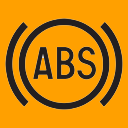Automobile Repair/Warning light system
Brake Light Warning Light
[edit | edit source]
Cause: The brake fluid level drops to near the "MIN" line of the brake fluid reserve tank, while the engine is running.
Actions: Add the brake fluid, if necessary, and check the fluid leakage. If the warning light goes on, the brake system requires increased force and the stopping distance will be increased.
If this light fails to go out even when the parking brake has been released, or if the light goes on while running, most likely the brake fluid level has dropped, resulting in poor braking. When the effectiveness of the brake has dropped, immediately park your car at a safe place by depressing the brake pedal strongly.
Note 1: When both this light and the anti-lock brake system warning light go on at the same time, the anti-lock brake system may be malfunctioning. In addition, there is the possibility that the vehicle becomes unstable when hard braking is applied. Immediately park your car at a safe place.
Note 2: When an abnormal noise (squeaking noise, etc.) is always emitted during the braking period, most likely the brake pad has been worn out. Immediately have your car checked.
Battery Charging Warning Light
[edit | edit source]
Cause: The charging system (alternator) should be malfunctioned if the warning light goes on while the engine is running, the drive belt may loose or break.
Actions: Once the battery is noticed turned on, it is best to turn off the accessories (dashcam/radio/CD player/etc...) and drive to nearest workshop for checking.
Wait for the engine to cool down first and and use the battery checker to check for the battery capacity ;if battery capacity mentioned OK
Then check drive belt for looseness or breakage. Replace drive belt if found broken.
Then check for alternator is charging using battery checker.
Note 1: Do not continue driving if the drive belt is broken or loose. It may cause engine overheating.
Note 2: If the car is very hard to kick start to running engine, there is a high chances of battery unable to be perform its duties anymore.
Anti Lock Breaking System (A.B.S) Warning Light
[edit | edit source]
Cause: The brake fluid level drops to near the "MIN" line of the brake fluid reserve tank, faulty speed sensor on one or more tyres if it detect the tyre speed variances is more than certain ranges, blown fuses causing the ABS module to be short circuit
Note 1: If both the A.B.S. warning light and brake warning light should remain illuminated and fall to go out, there is the possibility that the braking forces would drop drastically, it is likely braking system will fail. Stop the car at roadside to prevent accidents.
Actions: Stop the car and top up the brake fluid in brake fluid reserve tank
Note 2: The ABS does a self-test every time you turn on the ignition. Once you start your vehicle, the warning light will briefly come on, and if the A.B.S Module finds a problem, the light will stay on. If you notice the light flash immediately after starting the vehicle, then it's just your vehicle doing a self-check.
Note 3: If the warning light comes on while you are driving, it means the ABS is not working properly. Your brakes will still work, but the ABS might not engage if you need to make an emergency stop. If the light remains on, you need to have it checked the ABS light issue as soon as possible to ensure that emergency brake still functions if you needed it.
Engine Malfunction Indicator Light (EMIL)
[edit | edit source]
Cause: ECM (Engine Control Module) detects excessive consumption (fuel), excessive exhaust smoke (combustion failure) or an abnormal operating temperature (a cooling system failure). ECM itself maybe faulty if others potential issues are checked by mechanics to be OK
Note 1: If the engine electronic control system should malfunction while the engine is running, the MIL goes on.
Actions: Stop at the road side and checked for the following:
(i) Check the petrol cap is properly closed off when you last filled it up
(ii) If petrol cap is closed properly and light is still flashing, get the car towed and checked at nearest workshop.
Note 2: Continue driving in this conditions will lead to more engine damages
